Abstract
Opera houses are often used as concert halls with the use of a temporary acoustic shell set on stage. In most cases, the shell shape and its position in the fly tower are decided by theatre technicians, after evaluating the concert programme and considering the conductor and the musicians’ requests, without being supported by an acoustic analysis. This paper describes the acoustic shell influence on the acoustic field of a baroque theatre when changing its dimensions and the orchestra staff, with and without the choir, when the theatre is used as a concert hall. The “Opera di Roma” case study is presented, and the main acoustic parameters’ trends and their sensitivity are analyzed. The shell layout optimization, which is suggested in the prediction analysis of the case study, does not coincide with the ones preferred by the musicians. The main reasons for this controversial result are explained in the paper, underlining the rules determining the musicians’ opinions during the acoustic design and/or analysis process, to better focalize the applied acoustics activities.
1. Introduction
Acoustic shells are used to improve the sound early reflections of a performance on stage, supporting the acoustic field of the surrounding space. They can be installed in different contexts, outdoors and indoors.
However, there is not much research about acoustic properties and the effects of acoustic shell forms and their modifications. Some advice for the design in practice was discussed in the past [1]. A minimum volume was suggested [2]; Bradley [3] presented room acoustic measurements of the effects of adding or modifying an orchestra shell in three multipurpose halls. It was also observed that an absorptive back wall of orchestra shells would be preferred by musicians [4]. More recent studies have focused on the acoustic shell design for outdoor applications [5,6,7], even if it is becoming more common, nowadays, to install them in historical theatres when concerts are being held on stage. Acoustic shells help to achieve longer reverberation time requirements compared to the theatre hall configuration.
This solution brings about a significant alteration in the acoustic environment, effectively isolating the Fly Tower volume behind it, and defining a considerably larger active acoustic space. The outcoming acoustic field results in different average values of the main acoustic parameters.
The necessity of using baroque theatres as concert halls or as multipurpose spaces is related to economic reasons, a lack of human resources and leadership, and strategy organization, for which it has become increasingly apparent that theatres, which are dedicated to just one single use, are no longer sustainable. Especially in large cities, a degree of flexibility is required to transform the space from speech or music uses to drama, performances or fashion show configurations [8,9,10]. In this context, satisfactory acoustic properties must be achieved for concerts as well as for theatrical performances and congresses [11].
In a baroque theatre, the audience feels enveloped and surrounded by the sound. However, the reverberation time is shorter than in a concert hall, and, according to volume, construction time and location, it can achieve an optimal range between 1.3 and 1.8 s in occupied conditions [12,13,14]. Usually, the reverberation time rises with decreasing frequency, yielding a beneficial sense of musical warmth below 500 Hz.
In concert halls, during rapid musical passages, the acoustic parameters clarity and definition can be appreciated in detail, thanks to the reflections coming from supporting surfaces, which are located close enough to the audience to ensure a short initial time delay gap. In addition, the sound has adequate loudness that is evenly distributed throughout the hall, and a wide bandwidth is supported, considering that musical instruments generate sounds from 30 Hz to 12,000 Hz, which is much broader than the spectrum of speech [15].
Acoustic shells are temporary constructions which can transform a theatre into a concert hall and can be installed in different configurations on stage. They vary in dimensions and shape according to the musicians needs, between symphonic music, with or without choruses, chamber music, and solo performances. They are usually designed and implemented with a modular system, which allows for different storage procedures, following the operational scene and acoustic needs.
Usually, an acoustic shell is made up of two main types of elements, the ceiling and the wall elements, so-called “towers”. The ceiling is made of modular elements, hung to the multiline hoists of the fly tower to be adapted in different tilted positions according to the requests. Towers are usually self-supporting walls complete with weights and stabilizers, that can be closed and moved on rubber wheels. Sound-diffusing convex surfaces of multi-layer curved wood structures are hung on the back frames of steel sections. The ceiling is composed of modular wooden panels, suspended and adjustable by means of motorized rigging to also reduce its dimensions for storage. Many different types of wood and finishings can be chosen, including fire-retardant wooden materials (Figure 1).
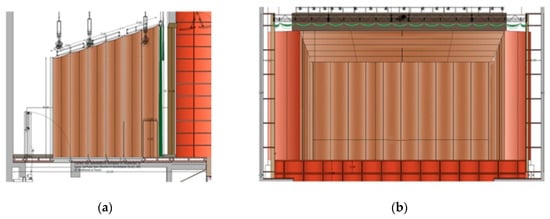
Figure 1.
Acoustic shell: longitudinal (a) and transversal section (b) section.
Acoustic shells also support rehearsal activities. For musicians’ practice, in fact, many rehearsal rooms with different volumes, shapes and cladding materials are necessary. Rehearsal rooms differ not only because of their dimensions and geometrical properties, but also because of their acoustic response, according to the type of ensemble (number of musicians) and repertoire. In opera houses in particular, rehearsal rooms for choirs would be recommended [16,17,18], but in many baroque theatres, built on the pass, these spaces were not included in the design, and to add them nowadays is quite impossible. In these conditions, an acoustic shell on stage often represents a good compromise for rehearsal activities.
As for spaces designed specifically only for one use, theatres are considered to have specific acoustic characteristics, which are defined by the absorption surfaces’ properties, the volume, and the shape of the hall, and nowadays, like the concert halls, they must deal with changing circumstances [19] during their life cycle. For example, hall occupation changes happen at different time scales: there is rapid change through different activities throughout a single day (rehearsals activities and concerts), medium-term change that occurs as result of re-organizations (concert for chamber orchestras instead of for big orchestras), and longer-term changes that might impact environmental and acoustic conditions [20,21]. For these reasons, it becomes mandatory to support the set of the acoustic shell with an acoustic analysis to predict its effects on the sound filed, according to its shape and dimensions.
The set of an acoustic shell should always be supported by an acoustic analysis to optimize the results in other performing spaces as well, like open theatres [22], circuses [23], squares, and ancient (Figure 2) or modern churches [24] if used for concerts, and generally in spaces with multifunctional activities where the shell can be installed. The optimization of the acoustic shell, achieving the preferred reverberation time, increases the multipurpose capability of the space, as an evaluation of the single acoustic quantity index MI could confirm [25]; it could also help to better control the acoustic features after refurbishment [26].
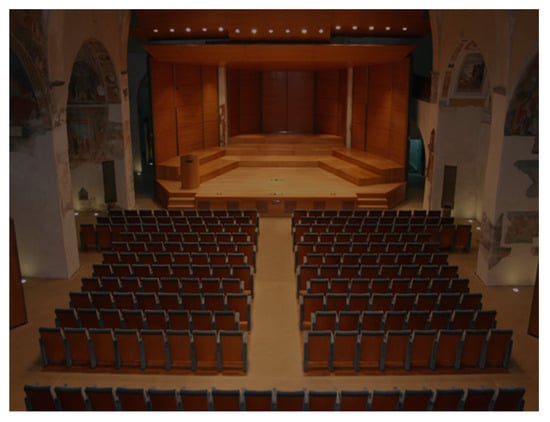
Figure 2.
Acoustic shell installed in the Church of Santa Marta, Morbegno (Sondrio, Italy).
An acoustic shell installation supported by an acoustic analysis could also be greatly appreciated in avoiding focalizations from boundary concave surfaces [27], increasing the uniformity of the sound field in general.
In the second section, the paper explains both the acoustic field differences and continuities of a space which is transformed from an opera house into a concert hall. In the third section, the acoustic shell optimization for the “Opera di Roma” is presented, while in the fourth sections results are discussed and musicians’ opinion are considered. Conclusions follow.
The study is focused on results obtained for a single case study, for which the acoustic shell shape is a compromise between the musicians’ and acousticians’ evaluations, but it could be useful in other theatres, for which, musicians’ opinions should be collected to evaluate the optimization of the acoustic shell, to satisfy both the acoustic quality and the musicians’ wishes.
2. Methodology to Transform the Sound Field from Opera to Concerts
Because baroque theatres are used as concert halls or as multipurpose spaces; firstly, it is recommended to follow the EN ISO 3382.1 [28] to check the acoustic field quality. The standard clarifies that “the reverberation time of a room was once regarded as the predominant indicator of its acoustical properties. While reverberation time continues to be regarded as a significant parameter, there is reasonable agreement that other types of measurements, such as those of relative sound pressure levels, early/late energy ratios, lateral energy fractions, interaural cross-correlation functions and background noise levels, are needed for a more complete evaluation of the acoustic quality of rooms” [21]. For this reason, the optimal acoustic range for other main acoustic quantities is suggested, considering a generic multipurpose use of the hall, according to the following table (Table 1):

Table 1.
The optimal acoustic range for the main acoustic quantities for a generic multipurpose use of the hall according to the ISO 3382.1 [28].
The standard does not subdivide this interval according to the main possible activities inside the space (concerts, speech, film projections, opera, etc.), even if it is known that the sound fields of spaces for speech are not optimized for classical music, and vice versa, as the following graph specifies (Figure 3).
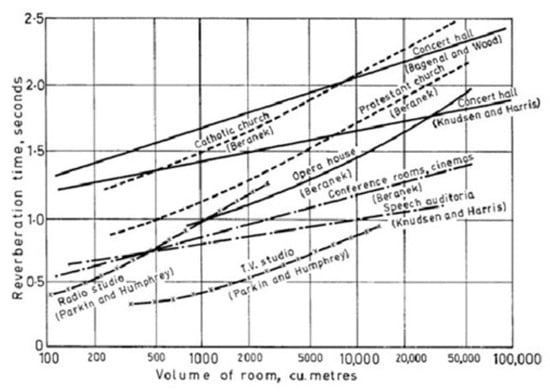
Figure 3.
Optimum reverberation time as a function of the space volume [29].
To find out the reference acoustic values for each activity, an optimal range of reference must be found in the literature [8,13,30,31,32].
In operas, both the singer’s voice and the musical instruments must be appreciated.
Short reverberation times are common in theatres predominantly designed for drama where a reverberation time of only 1 s is suggested. This value is certainly shorter than the ideal for music. A reverberation time of 1.8 s is ideal for orchestral music [33,34] in concert halls, but it is inappropriate for speech intelligibility.
The conflicting acoustic requirements for speech intelligibility and musical performances for Opera beg the question of the appropriate reverberation time for opera houses. A compromise is necessary. Reverberation times for opera between 1.3 and 1.8 s are appropriate; the exact point on this range can be chosen according to the volume, the number of seats and the taste of the audience.
The appropriate frequency characteristics for the reverberation time in opera houses are also in between the requirements for speech and music.
A longer bass reverberation time is undesirable for speech. Neither is it desirable for the orchestral sound in an opera house in the stalls, since high frequency sounds are suppressed due to absence of sightlines into the pit. A maximum rise of 20 per cent at 125 Hz relative to the mid-frequency reverberation time is likely to be acceptable. At the other extreme of the frequency range, the presence of the ‘singing formant’ suggests that reverberation times at 2 and 4 kHz should be maintained as long as possible.
One aspect that applies to both speech and music requirements is the importance of early sound compared to late reverberant sound.
Intelligible speech relies on a prominent early sound relative to the later reverberation, whereas for music, the emphasis is on the later sound, often achieved through a longer reverberation time. In the case of music, enhanced early reflections contribute to clarity and a sense of envelopment, especially when the reflections come from the sides. However, strong overhead reflections are considered undesirable for music. On the other hand, the direction of reflections is not a concern for speech. Additional lateral reflections that arrive early enough to improve speech intelligibility can be seen as beneficial for both speech and music applications, as they enhance the overall listening experience in a multipurpose hall. According to the characteristics of the room space, the literature for the optimal reverberation time follows [1] (Table 2):

Table 2.
Reverberation time optimal range suggested by the literature.
For the average values of the other acoustic parameters, their main optimal range is also indicated (Table 3):

Table 3.
Average values’ optimal range for the main acoustic parameters.
The optimal interval for baroque theatres is confirmed in most Italian ones [35,36,37] both with measurements and/or prediction analysis using acoustic software.
For opera houses, some suggestions regarding the way of propagating the sound energy between the hall and the fly tower are found in the literature [38,39,40], even if they are still a subject of research [41]. In many cases, for acoustic simulations, the virtual model is considered to be at one single volume, including the hall and the stage, surrounded by heavy absorbing draperies. Three different source positions are usually set [42].
If an acoustic shell is installed on stage, with frames in contact with the proscenium opening, the set configuration increases the volume of the hall, without adding a significant quantity to the total equivalent sound absorption area. Usually, acoustic shells are made of reflecting wood panels, which naturally help to increase the reverberation time in the hall. In particular, the volume within the acoustic shell makes it possible to increase the acoustic active volume of the hall significantly, according to the dimensions of the acoustic shell itself, and the diffusive coefficients of its panels.
From Opera to Concerts: The Hall Active Volume Increasing
In the above-cited literature, the optimal range for the ratio between the volume of the hall and the number of spectators is described (Table 4) according to different activities.

Table 4.
Optimal range of the ratio between hall volume and spectators [39,40,41].
According to the seating capacity, a theatre can be described as a small, medium, large or grand opera. The referred volume range follows (Table 5):

Table 5.
Volume range for theatres and concert halls according to the seat’s capacity.
According to the hall volume, the proscenium opening dimensions can be estimated, as suggested by the following table (Table 6) [43]:

Table 6.
Proscenium and Stage dimensions.
To preliminarily estimate the acoustic shell volume on stage, the orchestra distribution and the surface occupation must be evaluated first. Two main layouts are identified:
- Layout 1: The orchestra is placed only inside the acoustic shell, which is installed in the fly tower (Figure 4); the choir can also be included. This layout refers to that of a big acoustic shell.
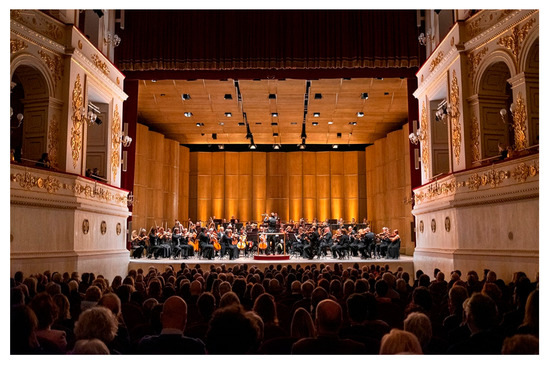 Figure 4. Acoustic shell on the stage of Galli Bibiena Theatre, Italy.
Figure 4. Acoustic shell on the stage of Galli Bibiena Theatre, Italy. - Layout 2: Only the last rows of the orchestra are inside the shell (the choir can also be included); the other orchestra instruments and the conductor are on the proscenium platform, extending into the hall (Figure 5). This layout refers to a small acoustic shell.
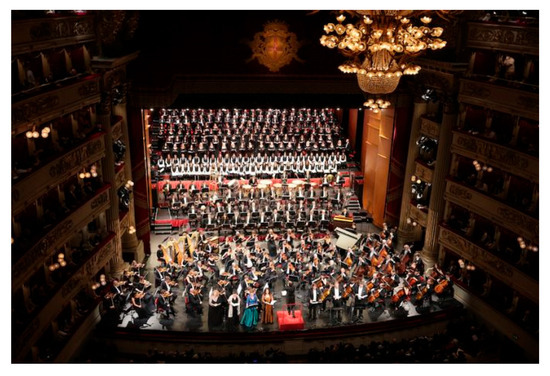 Figure 5. Acoustic shell in the Alla Scala Theatre in Milan, Italy.
Figure 5. Acoustic shell in the Alla Scala Theatre in Milan, Italy.
The range for the depth of the acoustic shell volume, referring to the two main different layouts mentioned above, follows (Table 7):

Table 7.
The acoustic shell volume depth range for the 2 main layouts.
The acoustic shell volume range and the average ratio shell volume/seats are evaluated (Table 8).

Table 8.
Volume range and average ratio volume/seats.
From Table 8, it can be deduced that, adding the shell volume to the hall volume, the new active theatre volume/seating ratio increases significantly, especially for layout 1, approaching naturally the optimal ratio for concert halls.
This approach justifies the installation of a large acoustic shell on stage to enable the use of a theatre for classical concerts.
3. The Case Study
Born from the determined vision of its founding father, the theatre was commissioned by construction entrepreneur Domenico Costanzi, from whom its name derives. Its establishment was commissioned by Costanzi himself in 1879 to the Milanese architect, Achille Sfondrini, who specialized in theatre construction. The outcome of the project was a neo-Renaissance-style theatre focused on acoustic excellence through the use of a horseshoe-shaped structure.
The Teatro Costanzi was inaugurated on 27 November 1880, with Gioachino Rossini’s Semiramide, in the presence of King Umberto I and Queen Margherita. With three tiers of boxes, an open level, and a gallery accommodating up to 2.200 spectators, the new “home” for opera in Rome was born.
Only in 1926, at the behest of Benito Mussolini, did the Municipality of Rome acquire the Costanzi, renaming it the “Teatro Reale dell’Opera”. This transition led to a renovation, undertaken by architect Marcello Piacentini, which relocated the theatre’s entrance and embellished the interiors, the current third tier, and a balcony. Furthermore, a majestic chandelier adorned with twenty-seven thousand crystal drops was mounted in the middle of the ceiling. In 1946, the theatre embraced the newly born Italian Republic and became the “Teatro dell’Opera di Roma” (Table 9). The look that the audience may still appreciate today was established though a renovation by Piacentini in 1958, in preparation for the 1960 Olympics.

Table 9.
“Opera di Roma” data.
3.1. The Opera House Used as a Concert Space
Each possible theatre arrangement (stage extension, acoustic shell and traditional curtain) requires not only a specific range of reference for reverberation time but also some approximate geometrical limits for the seat capacities and for the audience distance from stage.
When using the opera house as a concert hall, care must be taken to define the main geometrical parameters, the architectural style, the volume, the shape and proportions of the room. It is also challenging to naturally achieve a change in Reverberation Time to adapt the opera house for concerts. The hall volume and total acoustic absorption become the two main variables for this disposal.
For the concert configuration and its longer reverberation time requirements, compared to the opera configuration, an orchestra shell (made of acoustically reflective materials) was installed on stage. This solution brings about a significant alteration in the acoustic environment, effectively isolating the fly tower volume behind the acoustic shell panels and defining a considerably larger active acoustic space that results in a longer reverberation time compared to reverberation time in the main hall, if an opera set is on stage.
In the case study, three different acoustic shell configurations are analyzed in detail, through acoustic simulations with Odeon software, starting from the model’s calibration, for which the RT measurements on site were taken as reference.
The acoustic shell implemented in the “Opera di Roma” model has a depth of 8 m, a lateral taper of 12 and a height of 12 m at its highest level.
The first virtual model (layout 1, big acoustic shell) represents the acoustic shell with the orchestra placed on stage, in order to achieve the concert hall use for the theatre. In using the theatre as a concert hall the orchestra pit is removed in favour of a stage extension (OAC2).
In the second model (layout 1, big acoustic shell) the stage extension is present, and some steps are placed near the back wall of the acoustic shell, to be occupied by the choir (OAC3).
The third model is characterized by a shorter acoustic shell and the orchestra is placed on the stage extension (OAC5) (layout 2: small acoustic shell).
3.2. Acoustic Modelling, Measurements and Calibration
The construction of the 3D model is a very long time-consuming process that requires the creation of a continuous closed surface volume that satisfies the requirements imposed by the acoustic simulation software (ODEON) and the necessary geometrical simplifications (Figure 6). The geometry reduction in room acoustics modelling is a complex topic, with regards to controlling sensitivity and the modelling uncertainty, which would require a separate work on its own to explain in detail [44,45]. For this case study, some absorption coefficients were chosen from the literature, and some were found through measurements, as better explained in the paragraphs below. The scattering values were chosen based on recommendations given by the ODEON programme [46].
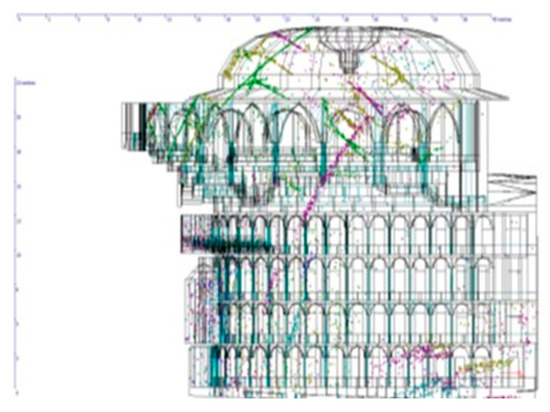
Figure 6.
Acoustic model with sound waves representation (Odeon).
The SketchUp 3D modelling software was used first, to create a virtual geometric model. The model was exported to Odeon, to carry out the acoustic assessment; absorption coefficients, source, and receivers’ positions were specified (Figure 7).
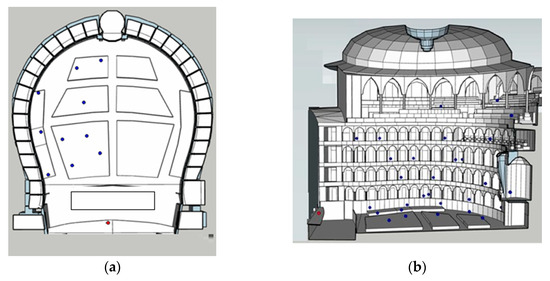
Figure 7.
Source (red) and receivers (blue) positions in plan (a) and in section (b).
The length of the room’s impulse was set manually considering the measured data to calibrate the model. The absorption coefficients of all materials were defined first according to the reference values in the literature.
The creation of the virtual model was preceded by some preliminary considerations about the theatre volume: some authors [47] propose that the volume which must be taken into account is that of the main hall, excluding the volumes of the fly tower, the boxes, and the gallery. In the end, the proposal by Hidaka and Beranek [38], accepted by other researchers [28] was followed. It argues that opera houses can be analyzed as coupled volumes if they have large stage houses or hard reflecting surfaces characterized by partial draperies or empty stages; otherwise, only a single volume must be considered.
As the way sound energy propagates between the hall volume and the fly tower is still a subject of research [42], a decision was made to consider the virtual model as one single volume and to avoid modelling the fly tower.
The measurement survey aimed to check the reverberation time T30 and C80, considering those to be sufficient for the calibration process [48]. The measurement procedure was in accordance with ISO 3382-1 [28]. The sound was given by an omnidirectional source: a dodecahedron speaker with a sine sweep signal. Free-field microphones in class 1 (BSWA TECH MPA201) were used. They were wire connected to an Integrating Sound Level Meter and Real Time 4 channel analyzer (Soundbook), and they were placed faced up, in every chosen receiver position, to capture the diffuse sound field. The signal analysis was developed using Samurai software. Measurements were repeated twice in every receiver position.
During the measurements, with it not being possible to set an acoustic shell on stage, it was decided to configure the hall with a closed house curtain, while the source was placed 15 cm from the stage front, at a 1 m distance from the longitudinal axis of the hall. Temperature and relative humidity parameters were equal to the ones in the simulations. The hall was unoccupied.
The chosen configuration for the measurements was considered to minimize the modelling uncertainty for different reasons. In the calibration process, the uncertainty in fly tower modelling was avoided by replacing it with the house curtains; fly tower modelling was also not requested in the simulations (being that the stage area was replaced by the acoustic shell). Furthermore, the well-known absorption coefficients of the house curtains were introduced, having been measured in a reverberation chamber [49], focusing the calibration process only on the theatre hall surfaces. The house curtains’ absorption coefficients follow (Table 10):

Table 10.
House curtain absorption coefficients.
The hall absorption coefficients, which remained fixed in the different compared simulations, needed to be identified. The chosen configuration made it possible to start the calibration process, considering the seating area as the main absorption surface of the hall, and allowing, at the beginning, the use of the “residual absorption coefficients”, i.e., the total absorption, for all the walls, the ceiling, and the balcony fronts, that did not exceed the one proposed by Beranek and Hidaka [50,51], while the absorption coefficients of the seating area referred to the medium upholstered seats, indicated in the same authors’ study [51].
To reduce the uncertainty in comparing the results, the wood panels characteristics were fixed by changing the shell layout, only increasing or decreasing their quantity without changing their acoustic properties.
The measured RT and C80 values, for the calibration process referred to the theatre configuration in which the house curtains are closed. The difference between the simulated and the measured values are inside 1 JND [21] (Figure 8).
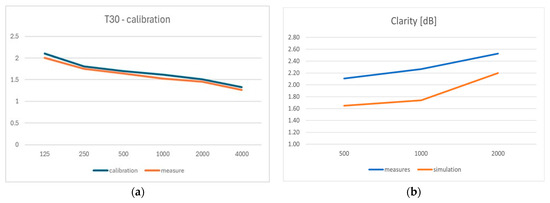
Figure 8.
Simulated and measured T30 (a) and C80 (b) values.
In the simulation model, the wood panels’ absorption coefficients were taken into consideration. Values from the literature were studied first (Table 11) [52]:

Table 11.
Typical absorption coefficients of various type of wood panels [52].
According to this table, wood panels are generally light partitions, which have their maximum absorption at low frequencies. Therefore, such constructions can make up for the low absorptivity of an audience and thus achieve a more uniform frequency dependence on the reverberation time.
Simplified models to predict the reflections from finite objects [53], the diffusion properties for elements with finite dimensions [27], and the attenuation or gain due to panel curvature (Rindel) [53] were also considered.
In the end, data obtained in a reverberation chamber were used [49]. The tested panels were made of wood; the areic mass was equal to 13 kg, the dimensions were 1.5 m by 1.5 m each, the radii were equal to 5 m. The panels were screwed onto an aluminum frame, linked to a vertical truss structure. Between the frame and the trusses, neoprene strips, 3 mm thick, were inserted. The measured absorption coefficients follow (Table 12):

Table 12.
Wood panels measured absorption coefficients and diffusion.
Working in the digital domain, the curved surfaces needed to be discretized in the virtual model, replacing the continuous curves with a succession of straight lines. The scattering coefficients were defined according to the panel radius and the geometry discretization of the curve [46], evaluated as equal to 5% for lower and higher frequencies, and equal to 10% at central frequencies (500 and 1000 Hz).
3.3. Acoustic Simulations and Results
Three different acoustic shell configurations are analyzed in detail (Figure 9).

Figure 9.
Acoustic shell: the three analyzed configurations. OAC 2 (a); OAC 3 (b); OAC 5 (c); OAC 5 (d).
The first virtual model represents the acoustic shell with the orchestra placed on stage, in order to achieve concert hall usability for the theatre. When using the theatre as a concert hall, the orchestra pit is removed in favour of a stage extension (OAC2).
In the second model, the stage extension is present and some steps are placed near the back wall of the acoustic shell occupied by the choir (OAC3).
The last model is characterized by a shorter acoustic chamber and the orchestra is mostly placed on the stage extension (OAC5).
The main simulation results are plotted in the following figures (Figure 10, Figure 11, Figure 12, Figure 13, Figure 14 and Figure 15). Standard deviations are plotted in tables (Table 13, Table 14 and Table 15).

Figure 10.
Big acoustic shell—internal orchestra (OAC2): parameters T30 (a), C80 (b), G (c).
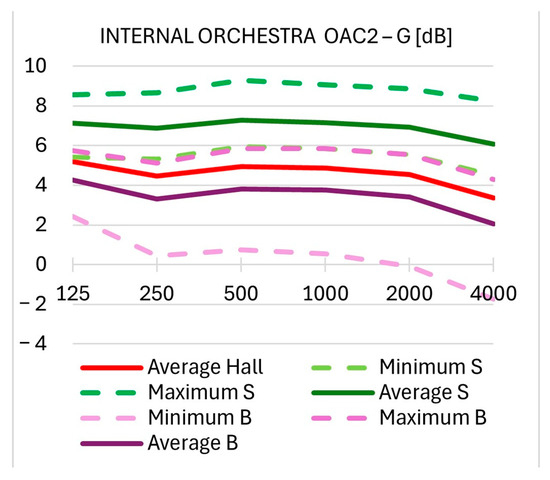
Figure 11.
Big acoustic shell G—data comparison (OAC2).

Figure 12.
Big acoustic shell: internal choir and orchestra (OAC3): T30 (a), C80 (b), G (c).
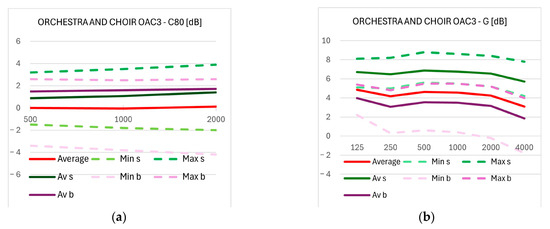
Figure 13.
Big acoustic shell C80 (a) and G (b); data comparison (OAC3).

Figure 14.
Small acoustic shell (OAC5): parameters T30 (a), C80 (b), G (c).
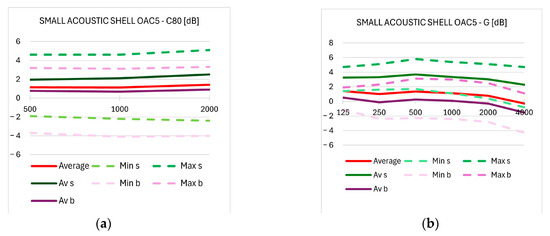
Figure 15.
Small acoustic shell C80 (a) and G (b); data comparison (OAC5).

Table 13.
Big acoustic shell: internal orchestra (OAC2).

Table 14.
Big acoustic shell: internal choir and orchestra (OAC3).

Table 15.
Small acoustic shell (OAC5).
4. Comparison of Results and Discussion
The reverberation time parameter is affected by both the dimensions of the acoustic shell and the number of musicians on stage (Figure 16).
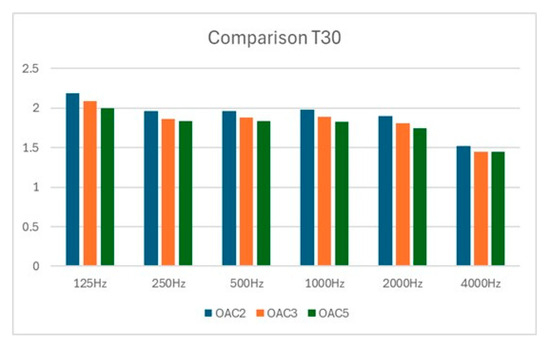
Figure 16.
Average T30 comparison for the three main configurations, OAC2, OAC3, and OAC5.
For each frequency, it decreases both as the number of musicians on stage increases and as the size of the acoustic shell decreases.
In detail, the orchestral ensemble increases more based on the presence of the choir, in the OAC3 configuration, and brings significant changes to the overall RT value compared to the OAC2 configuration. The difference between the overall values is equal to 1 JND; at the frequencies of 250 Hz, 2000 Hz and 4000 Hz, this trend was confirmed for receivers in the stalls and in the two lower levels of boxes, while in the upper levels, in some seat’s receivers (30% ca.), the change is smaller than 1 JND.
The small shell configuration significantly reduces the reverberation time at all frequencies compared to the OAC2 configuration, with differences approaching 2 JND at frequencies of 125 and 2000 Hz. These differences are spread to 80% of the receivers’ positions.
Regarding the standard deviation, in the configuration with the choir, the maximum standard deviation is observed only at the low frequency of 125 Hz (OAC3), while at other frequencies the maximum deviation shifts to the configuration with the larger acoustic chamber and orchestra only (OAC2). The minimum standard deviation is observed in the configuration with the smaller acoustic shell (OAC5). This results in greater uniformity of the sound field distribution.
As the number of musicians on stage increases, for the same acoustic shell dimensions, the TR is slightly reduced and the uniformity of the parameter distribution in the hall increases.
The C80 parameter is very similar in the two configurations, referring to a large acoustic shell (OAC2 and OAC3), significantly higher values are observed for the small acoustic shell OAC5, with an approximate change of 1 JND at all frequencies (Figure 17). These differences are spread in all the receivers’ positions.
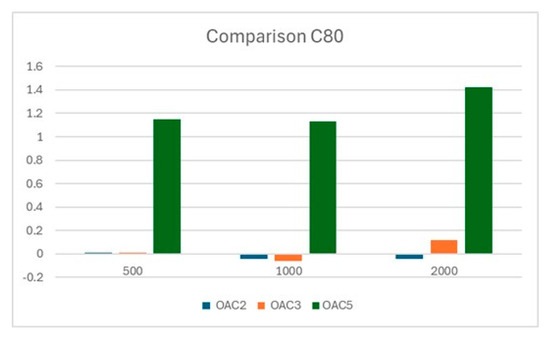
Figure 17.
Average C80 comparison for the three main configurations, OAC2, OAC3, and OAC5.
The C80 is more sensitive to a reduction in acoustic shell volume and less sensitive to changes in the number of musicians than the T30.
In the OC3 configuration, the mean C80 value of the boxes is higher, with larger standard deviations, than in the stalls.
In the OC5 configuration the standard deviation in the stalls does not differ significantly from the boxes, even if the mean value in the stalls is higher than that in the boxes.
The G parameter decreases almost significantly from the OAC2 to OAC3 configuration, not reaching 1 JND, while it exceeds 2 JND in the OAC5 configuration compared with both previous configurations (Figure 18). These differences are spread in all the receivers’ positions.
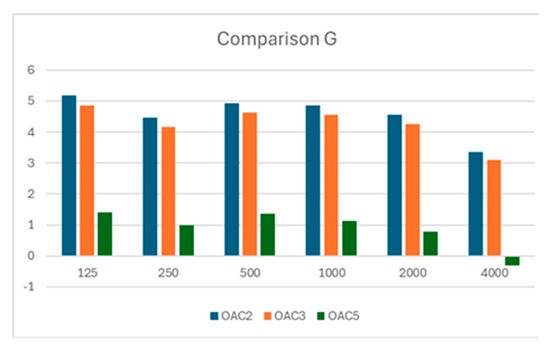
Figure 18.
Average G comparison for the three main configurations, OAC2, OAC3, and OAC5.
The G parameter is most affected by the decrease in acoustic shell volume compared to the other two parameters.
The average values of every single configuration are compared with the optimal range suggested in the literature (Table 16). The configuration that optimizes the acoustic field for concerts is the big acoustic shell (layout 1), both for the OAC2 and OAC3 configurations, for which the mean parameters values are in the middle of the suggested optimal range (Table 16).

Table 16.
Main acoustic parameters’ average values.
Musicians’ Opinion
A total of 64 musicians were interviewed to gather their opinions about their preferred configuration of the acoustic shell on stage. A simple questionnaire was used, which asked two questions. The first one asked musicians to choose their favourite layout between the two analyzed (the big shell and the small shell). The second one asked musicians to indicate their choice of why, between acoustic and comfort reasons, while adding some personal motivations.
90% reported that they preferred to play in the hall, justifying staying as close to the audience as possible, considering acoustic quality improvements by the acoustic shell of secondary importance. When asked whether their position corresponded to the optimization of sound distribution for the orchestra and in the hall, the answer was negative.
The musicians reiterated that, although a big, deep acoustic shell improves the sound field quality both for the players and the audience, it was more important for them to feel visually and physically closer to the audience by playing a symphonic piece, as in a concert hall. In concert halls, in fact, the stage is usually lower than that in a theatre and the first row is much nearer, as it is not constrained by the orchestra pit gap or by the pit itself used to create the extension of the stage.
Furthermore, musicians highlighted that they do not appreciate being positioned at the back, too far from the proscenium. For these reasons, they considered the small acoustic shell (layout 2) to be the best compromise.
For most of the musicians, the proscenium represents a separation line beyond which one is no longer part of the hall; that is, one becomes part of a show in which musicians have the psychological experience of not being part of the same space of the audience, even if the acoustic quality is improved.
Musicians instead confirmed the importance of isolating the stage space from the hall through a back wall, placed not so far from the proscenium, to avoid dispersing the sound behind them. For all these reasons, the reduced acoustic shell on the stage (OAC5) was chosen by the musicians as the best layout to satisfy both their psychological and acoustic necessities. They also argued that, in many visited theatres, big acoustic shells lay abandoned in the backstage of the fly tower.
Some practical discussions about new, modern, lighter construction technologies to hang the shell panels (such as aluminum and fibre-reinforced plastic polymers, which are entering the market [54,55,56]) were also taken into consideration, to give them the possibility of adjusting the panels’ position after the main layout has been fixed.
5. Conclusions
The acoustic shell size in a baroque theatre, as a function of proscenium and stage dimensions, confirms that its installation significantly influences the sound field of the baroque theatre itself, by transforming the acoustics’ quality to that of a concert hall.
In a baroque theatre, the reverberation time is affected by both the shape and dimensions of the acoustic shell and the number of musicians on stage.
In the presented case study, the RT decreases for each frequency, both as the number of musicians on stage increases and as the size of the acoustic shell decreases.
As the number of musicians on stage increases, for the same acoustic shell dimensions, the RT is slightly reduced and the uniformity of the parameter distribution in the hall increases.
The C80 parameter, referred to a large acoustic shell, is very similar in the two configurations (with and without the choir), has significantly higher values relative to the small acoustic shell, with an approximate change of 1 JND at all frequencies.
The C80 is more sensitive to a reduction in acoustic shell volume and less sensitive to changes in the number of musicians than the T30.
In the big acoustic shell configuration with choir, the C80 values in the boxes are higher than those in the stalls, also with a larger standard deviation.
In the small shell configuration, the standard deviation in the stalls does not differ significantly from the boxes, even if the mean value in the stalls is higher than that in the boxes.
The G parameter is also very similar in the two configurations, referring to a large acoustic shell, not reaching 1 JND by introducing the choir on stage, while it exceeds 2 JND in the small acoustic shell configuration compared with both previous configurations.
The G parameter is affected more by the decrease in acoustic shell volume compared to the other two parameters.
From the presented acoustic analysis, the configuration that optimizes the acoustic field for symphonic music is the one with the big acoustic shell, for which the mean parameter values are in the middle of the optimal range, as suggested by the literature. This configuration was recognized by the musicians to be the one with the best acoustics for concerts. Nevertheless, for psychological reasons, such as the need to feel as close as possible to the audience, interviewed musicians mostly preferred the reduced acoustic shell configuration, confirming the importance of isolating the stage space from the hall through a back wall, placed not far from the proscenium, to avoid dispersing the sound behind them, optimizing orchestra distribution on stage.
This paper would like to underline the rules regarding the musicians’ opinions during the acoustic design and/or analysis process, to better focalize the applied acoustics activities.
For this case study, in the case of the acoustic shell configuration made of reflecting wood panels, it was found that, even if a large volume better satisfies the acoustic conditions for concerts, a small shell represents dimensional optimization according to the musicians’ requests.
Collecting musicians’ opinions in a preliminary phase could be very useful to find easier solutions able to converge both acoustic quality and musicians’ wishes.
In further research, the acoustic shell dimensions optimization could be standardized according to the theatre dimensions, seating capacity and orchestra composition (number of musicians with or without choir), recommending a modular structure for easier adjustments on site, avoiding that big acoustic shells lay abandoned in the backstage of the fly tower. Given the widespread use of shells in other historic theatres and churches, the methodology adopted here could be investigated to enlarge the standards applications to those building typologies, also verifying whether similar objective–subjective divergences occur elsewhere.
Author Contributions
Conceptualization, A.T. and U.D.; methodology, S.S. and U.D.; software, U.D.; validation, A.T. and U.D.; formal analysis, U.D.; investigation, U.D.; resources, A.T. and U.D.; data curation, U.D.; writing—original draft preparation, S.S. and U.D.; writing—review and editing U.D.; visualization, U.D.; supervision, U.D.; project administration, A.T.; funding acquisition, A.T. All authors have read and agreed to the published version of the manuscript.
Funding
This research received no external funding.
Institutional Review Board Statement
Not applicable.
Informed Consent Statement
Not applicable.
Data Availability Statement
Survey data and simulation outputs are available.
Acknowledgments
We offer considerable thanks for all support given by S.A.C Construction Company in Rome for the technical support, the measurements data, and for the house curtains and shell absorption coefficients.
Conflicts of Interest
The authors declare no conflicts of interest.
References
- Jaffe, P. Design Considerations for a Demountable Concert Enclosure (Symphonic Shell). J. Aud. Eng. Soc. 1974, 22, 163–170. [Google Scholar]
- Kan, S.; Takaku, K.; Nakamura, S. A report on the relationship between orchestra shell design and musicians’ acoustic impression. In Proceedings of the 15th International Congress on Acoustics/ICA 95, Trondheim, Norway, 26–30 June 1995; pp. 525–528. [Google Scholar]
- Bradley, J.S. Some effects of orchestra shells. J. Acoust. Soc. Am. 1996, 100, 889–898. [Google Scholar] [CrossRef]
- Kahle, E.; Katz, B. Design of a new stage shell for the Stadthaus in Winterthur, Switzerland. J. Acoust. Soc. Am. 2004, 115, 2477. [Google Scholar] [CrossRef]
- Di Rosario, S.; Parenti, B.; Pignatelli, E.; Mirra, G.; Pone, S. ReS, Resonant string shell, development and design of an acoustic shell for outdoor chamber music concerts. In Proceedings of the Ninth International Conference On Auditorium Acoustics, Paris, France, 29–31 October 2015; Volume 37. [Google Scholar]
- Pignatelli, E.; Colabella, S.; Di Rosario, S.; Pone, S. A wooden acoustic shell for open-air chamber music concert. In Proceedings of the Symposia of the International Association for Shells and Spatial Structures, Amsterdam, The Netherlands, 17–20 August 2015. [Google Scholar]
- Shtrepi, L.; Badino, E.; Lancia, D.; Pone, S. Stage acoustics in an open-air performance acoustic shell. In Proceedings of the 10th Convention of the European Acoustics Association, Turin, Italy, 11–15 September 2023. [Google Scholar]
- Barron, M. Auditorium Acoustics and Architectural Design; Taylor & Francis: Abingdon, UK, 2009. [Google Scholar]
- Cairoli, M. The architectural acoustic design for a multipurpose auditorium: Le Serre Hall in the Villa Erba Convention Center. Appl. Acoust. 2020, 173, 107695. [Google Scholar] [CrossRef]
- Hans, M.; Joseph, M. Increasing liveness and clarity in a multipurpose civic center. J. Acoust. Soc. Am. 2016, 140, 3294. [Google Scholar]
- Cairoli, M.; Tagliabue, L.C. Digital Twin for Acoustics and Stage Craft Facility Management in a Multipurpose Hall. Acoustics 2023, 5, 909–927. [Google Scholar] [CrossRef]
- Beraneck, L. Concert Hall and Opera Houses; Springer: Berlin/Heidelberg, Germany, 1996. [Google Scholar]
- Tronchin, L.; Merli, F.; Manfren, M. On the acoustics of the Teatro 1763 in Bologna. Appl. Acoust. 2021, 172, 107598. [Google Scholar] [CrossRef]
- Iannace, G.; Ianniello, C.; Maffei, L.; Romano, R. Room acoustic conditions of performers in an old opera house. J. Sound Vib. 2000, 232, 17–26. [Google Scholar] [CrossRef]
- Cairoli, M. Acoustical design of the Opera and Ballet Theatre in Astana, Kazakhstan. Appl. Acoust. 2023, 211, 109556. [Google Scholar] [CrossRef]
- ISO 23591:2021; Acoustics—Acoustic Quality Criteria for Music Rehearsal Rooms and Spaces. International Standardization Organization: Geneva, Switzerland, 2021.
- Cairoli, M. Wooden Rehearsal Rooms from the Construction Process to the Musica Performance. Acoustics 2024, 6, 114–133. [Google Scholar] [CrossRef]
- Olsen, J.G. Acoustics in rooms for music rehearsal and performance—The Norwegian experience. In Proceedings of the BNAM Proceedings, Oslo, Norway, 3–5 May 2021. [Google Scholar]
- Cavaglieri, L. Il Sistema Teatrale Storia dell’Organizzazione, dell’Economia e Delle Politiche del Teatro in Italia; Dino Audino: Roma, Italy, 2021. [Google Scholar]
- Cairoli, M.; Agostinelli, S. Concert Halls as Nearly Adaptive Spaces. Appl. Sci. 2024, 14, 3250. [Google Scholar] [CrossRef]
- Fausti, P.; Pompoli, R.; Prodi, N. Acoustics of opera houses: A cultural heritage. J.Acoust. Soc. Am. 1999, 105, 929. [Google Scholar] [CrossRef]
- Tronchin, L.; Farina, A. The acoustics of the former teatro “La Fenice”, Venice. J. Audio Eng. Soc. 1997, 45, 1051–1062. [Google Scholar]
- Cairoli, M. The architectural acoustic design for a circus: The case study of Rigas Cirks. Appl. Acoust. 2021, 173, 107726. [Google Scholar] [CrossRef]
- Cairoli, M. Identification of a new acoustic sound field trend in modern catholic churches. Appl. Acoust. 2020, 168, 107426. [Google Scholar] [CrossRef]
- Cairoli, M.; Iannace, G. A Single Acoustic Quantity Index as Part of an Early-Stage Digitalized Procedure for the Restoration of Baroque Theatres to Be Used as Multipurpose Spaces. Heritage 2024, 12, 6749–6771. [Google Scholar] [CrossRef]
- Bevilacqua, A.; Tronchin, L. Evaluation of Acoustic Features after Refurbishment Works Inside Two Historical Opera Theatres Located in ItalyBASEL. Acoustics 2021, 3, 316–336. [Google Scholar] [CrossRef]
- Cairoli, M. Ancient shapes for modern architectural and acoustic design: Large interiors formed by curved surfaces. Appl. Acoust. 2020, 170, 107497. [Google Scholar] [CrossRef]
- ISO 3382-1 (2009); Acoustics. Measurement of Room Acoustic Parameters. Part 1: Performance Spaces. ISO: Geneva, Switzerland, 2009.
- Harris, C.M. Handbook of Noise Control; McGraw Hill: New York, NY, USA, 1997. [Google Scholar]
- Arau, H. Renovating Teatro alla Scala Milano for the 21st century, Part II. J. Acoust. Soc. Am. 2005, 117, 2522. [Google Scholar] [CrossRef]
- Barron, M. Theory and measurement of early, late and total sound levels in rooms. J. Acoust. Soc. Am. 2015, 137, 3087–3098. [Google Scholar] [CrossRef]
- Prodi, N.; Pompoli, R. Guidelines for acoustical measurements inside historical opera houses: Procedures and validation. J. Sound Vib. 2000, 232, 281–301. [Google Scholar]
- Beranek, L.L. Concert hall acoustics: Recent findings. J. Acoust. Soc. Am. 2016, 139, 1548. [Google Scholar] [CrossRef]
- Beranek, L.L. Analysis of Sabine and Eyring equations and their application to concert hall audience and chair absorption. J. Acoust. Soc. Am. 2006, 120, 1399. [Google Scholar] [CrossRef]
- Tronchin, L.; Bevilacqua, A. 3D Acoustic Map Analysis of the National Theatre of Zagreb. Appl. Sci. 2024, 14, 4365. [Google Scholar] [CrossRef]
- Bevilacqua, A.; Tronchin, L. The Bell-Shaped Opera Houses Realised by Antonio Galli Bibiena: Acoustic Comparison between the Communal Theatre of Bologna and the Scientific Theatre of Mantua. Acoustics 2023, 5, 586–600. [Google Scholar] [CrossRef]
- Hidaka, T.; Beranek, L.L. Objective and Subjective Evaluations of Twenty-Three Opera Houses in Europe, Japan, and the Americas. J. Acoust. Soc. Am. 2000, 107, 368–383. [Google Scholar] [CrossRef]
- Bevilacqua, A.; Iannace, G. From Discoveries of 1990s Measurements to Acoustic Simulations of Three Sceneries Carried out inside the San Carlo Theatre of Naples. J. Acoust. Soc. Am. 2023, 154, 66–80. [Google Scholar] [CrossRef]
- Perigot, S. Acoustic modelling parameters of flytower theatres: Presentation of a case study. Proc. Inst. Acoust. 2018, 40, 3. [Google Scholar]
- Jeon, J.Y.; Kim, J.H.; Ryu, J.K. The effects of stage absorption on reverberation times in opera house seating areas. J. Acoust. Soc. Am. 2015, 137, 1099. [Google Scholar] [CrossRef]
- Garai, M.; Cesaris, S.D.; Morandi, F.; D’Orazio, D. Sound energy distribution in Italian opera houses. In Proceedings of the 22nd International Congress on Acoustics: Acoustics for the 21st Century, Buenos Aires, Argentina, 5–9 September 2016. [Google Scholar]
- Tronchin, L.; Bevilacqua, A. Acoustic study of different sceneries at the São Carlos national theatre of Lisbon. Appl. Acoust. 2021, 180, 108102. [Google Scholar] [CrossRef]
- Ogawa, T. Theatre Engineering and Stage Machinery; Entertainment Technology Press: London, UK, 2001. [Google Scholar]
- Savioja, L.; Svensson, U.P. Overview of geometrical room acoustic modeling techniques. J. Acoust. Soc. Am. 2015, 138, 708. [Google Scholar] [CrossRef]
- Koutsouris, G.; Norgaard, A.K.; Christensen, C.L. Discretisation of curved surfaces and choice of simulation parameters in acoustic modeling of religious spaces. In Proceedings of the 23rd ICSV, Athens, Greece, 10–14 July 2016. [Google Scholar]
- Christensen, C.L.; Koutsouris, G.; Gil, J. ODEON Room Acoustics Software, User’s Manual; Odeon A/S: Lyngby, Denmark, 2016. [Google Scholar]
- Beranek, L.L. Audience and seat absorption in large halls. J. Acoust. Soc. Am. 1960, 32, 661. [Google Scholar] [CrossRef]
- Postma, B.N.J.; Katz, B.F.G. Creation and calibration method of acoustical models for historic virtual reality auralizations. J. Virtual Real. Soc. 2015, 19, 161–180. [Google Scholar] [CrossRef]
- ISO 354:2003; Acoustics—Measurement of Sound Absorption. ISO: Geneva, Switzerland, 2003.
- Hidaka, T.; Nishihara, N.; Beranek, L.L. Relation of acoustical parameters with and without audiences in concert halls and a simple method for simulating the occupied state. J. Acoust. Soc. Am. 2001, 104, 3169. [Google Scholar] [CrossRef]
- Beranek, L.L.; Hidaka, T. Sound absorption in concert halls by seats, occupied and unoccupied, and by the hall’s interior surfaces. J. Acoust. Soc. Am. 1998, 104, 3169. [Google Scholar] [CrossRef]
- Kuttruff, H. Room Acoustics; CRC Press: London, UK, 2009. [Google Scholar]
- Long, M. Architectural Acoustics; Academic Press: Cambridge, MA, USA, 2014. [Google Scholar]
- Cairoli, M.; Iannace, G. Modular Housing Using Fibre-Reinforced Plastic Polymers (FRPs). Buildings 2024, 14, 1854. [Google Scholar] [CrossRef]
- Iannace, G.; Ianniello, C.; Maffei, L.; Romano, R. Objective measurement of the listening condition in the old Italian opera house “teatro di san Carlo”. J. Sound Vib. 2000, 232, 239–249. [Google Scholar] [CrossRef]
- Bevilacqua, A.; Sukaj, S.; Ciaburro, G.; Iannace, G.; Lombardi, I.; Trematerra, A. How a quartet of theatres plays under an acoustic perspective: A comparison between horseshoe shaped plans in Campania. Build. Acoust. 2022, 29, 317–329. [Google Scholar] [CrossRef]
Disclaimer/Publisher’s Note: The statements, opinions and data contained in all publications are solely those of the individual author(s) and contributor(s) and not of MDPI and/or the editor(s). MDPI and/or the editor(s) disclaim responsibility for any injury to people or property resulting from any ideas, methods, instructions or products referred to in the content. |
© 2025 by the authors. Licensee MDPI, Basel, Switzerland. This article is an open access article distributed under the terms and conditions of the Creative Commons Attribution (CC BY) license (https://creativecommons.org/licenses/by/4.0/).